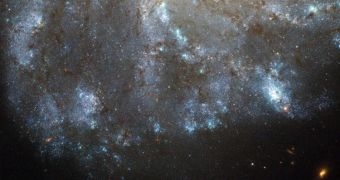In June 2010, the NASA/ESA Hubble Space Telescope captured an image of the nearby galaxy Messier 99. Upon close inspection of the photo, astronomers found a bright flash of light that could not be readily explained. To this day, experts can't seem to agree on what that might be.
M99 was being surveyed because it represents a fine example of what scientists refer to as a grand design spiral, a galaxy where the spiral arms are very long and clearly defined. As evidenced by the image to the left, Hubble focused its efforts on one side of the cosmic formation.
The object, which is relatively similar to the Milky Way, lies about 50 million light-years from Earth, which is considered to be close by in astronomical terms. It is a part of the Virgo Cluster, which contains in excess of one thousand other galaxies.
The flash is not the first unexplained phenomenon to be observed in Messier 99. However, the radiation observed from the yellow-orange star PTF 10fqs tops the list. It is significantly brighter than what experts would have expected to see from a nova, but a lot dimmer than a supernova.
Astronomers at the Palomar Transient Facility were the first to observe the weird star, and to attempt to classify it. They first thought it was a variable star, and then considered a supernova, but none of the proposed explanations was found to coincide with the observations.
One of the more unusual ideas experts developed to explain the nature of PTF 10fqs was that the bright flash was caused by a giant planet plunging into its parent star. However, there is currently no way to verify whether this is actually the case or not.
Thanks to the Hubble observations, astronomers now have a clear understanding of where the object is located. Even though the flash has since subsided, upcoming observations will enable astronomers to observe the source of the event.
This may in turn reveal more data about what actually happened in 2010. Over the years, astronomers identified a number of weird flashes occurring in several galaxies, and some of them have yet to be explained.
“A version of this image of Messier 99 was entered into the Hubble’s Hidden Treasures Competition by contestant Matej Novak. Hidden Treasures is an initiative to invite astronomy enthusiasts to search the Hubble archive for stunning images that have never been seen by the general public,” NASA reports.

 14 DAY TRIAL //
14 DAY TRIAL //